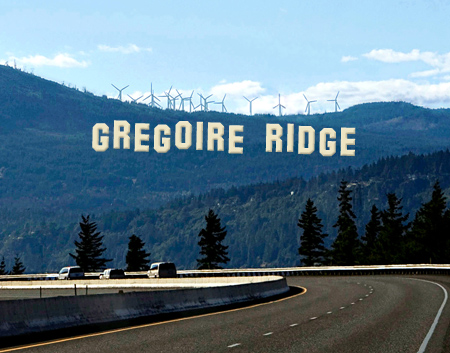







This is an archived article. Click here to return to the blog's home page.
Wind Turbines Blow Away Gorge Views
Entry 4: July 2, 2011 (updated January 11, 2013)
March 5, 2011 update: Governor Gregoire has approved the Whistling Ridge project. Unfortunately, she will be remembered as the governor who trashed the Gorge by allowing wind power development just outside its boundary, opening more land to this kind of destruction. Donate to Friends of the Columbia Gorge if you are in favor of challenging the decision in the courts.
In view of the monumental damage this decision will cause to the region's scenery by opening up wind power development to all comers, I think it's time to rename Whistling Ridge to Gregoire Ridge:
|
Image credits: Photo by Karen Chandler Simulation of turbines by GeoDataScape, Inc. Note: This is a simulated image, not a real one. The turbines shown have been approved but not built yet. |
Back to the main topic:
|
For decades Washington's Dog Mountain has been one of the most popular trails for hikers to take in spectacular views of wildflowers and to enjoy expansive horizons that encompass the entire length of the Columbia Gorge National Scenic Area. I've taken those views for granted, assuming they were protected. In the spring of 2011, I got a rude awakening. On a clear day I noticed that wind turbines in both Oregon and Washington are now visible in the east from the Puppy Mountain overlook just below the summit. Oregon's turbines are located in the Biglow Canyon area, and those in Washington, just outside the photo on the left side, are from the Windy Flats project south of Goldendale. I didn't believe it was possible for wind turbine farms to desecrate views in the central gorge. It shows how impacts can sneak up on us without warning or a fair public approval process. |
What Can I Do?
Click here to view contact information to comment on wind power impacts in the Columbia Gorge. Contact Governor Gregoire immediately to stop Whistling Ridge! |
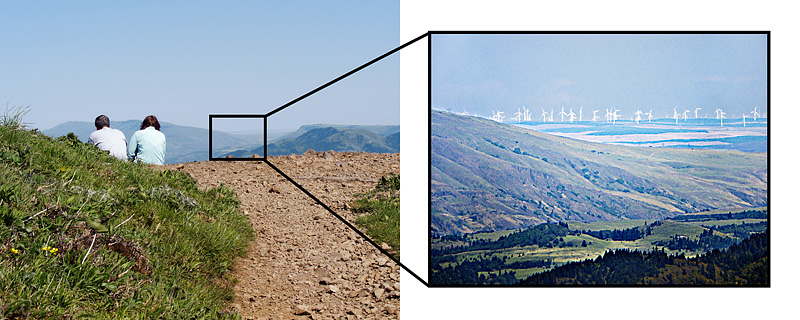
Dog Mountain Viewpoint (left) and Biglow Canyon Wind
Turbines (right, 10x zoom).
Another shoe is about to drop. Whistling Ridge (see map below) is a proposed project that's only five and a half miles from this viewpoint. While the turbines off to the east are small enough to miss on a cloudy day, the fifty turbines on Whistling Ridge will be close enough to be a real eyesore. They will be visible from Mitchell Point, Nestor Peak, the Columbia Gorge Hotel, portions of the Historic Columbia River Highway, Cathedral Ridge Winery, and many other sites where scenic interest is paramount.
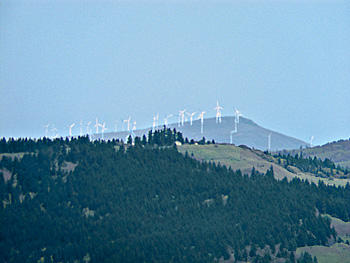
Windy Flats Turbines Viewed from Dog Mountain
It's too late to fix the Biglow and Windy Flats projects. But there is time for the Columbia Gorge Commission to oppose Whistling Ridge and the continuing assault on the view. Whistling Ridge isn't inside the Scenic Area boundary, but the Gorge Commission has every right to comment on it and their silence is telling. As we celebrate the 25th anniversary of the Scenic Area Act, we need to remember how important it is to be ever vigilant of new development threats. The Act was visionary when it was written, but could not anticipate new impacts that rapid changes in society and technology are creating. Now when we need it most, the system set up to protect Gorge views is failing us.
The Act contains a critical flaw. It does not specify buffer zones around the Scenic Area. We now see why that's wrong. Cities and counties can establish buffers, but we must move quickly before more projects are built. Three more are proposed in the sightline between Dog Mountain and Biglow Canyon.
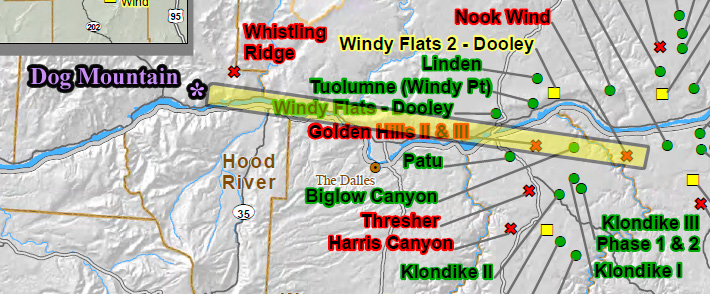
Golden Hills II/III and Nook Wind Projects in Dog Mountain Sightline
(red "x" indicates proposed project, green circle is an installed one)
Source: BPA
Wind Map
The big issue with not having buffer zones is the sheer size of the turbines. Whistling Ridge, as seen in the map above, is just outside the Scenic Area boundary at one of its narrowest places and only 2-1/2 miles from the Columbia River. The turbines that would be located there are nearly twice the length of a 747 jumbo jet, and one-seventh the height of Dog Mountain itself:

Wind Turbine Height Comparison
While these turbines would be illegal within the boundary, the Act as written allows them to be built a stone's throw away from it and at that close a distance to the Gorge they would be truly disastrous for recreation, tourism, and wildlife, some of the major reasons an estimated 8 million people visit the area each year to pump money into the local economy.
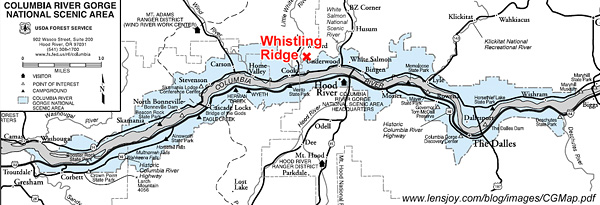
Columbia River Gorge Scenic Area Map (boundary in blue) showing Whistling
Ridge Site
High-quality downloadable map PDF
Link
The Commission needs to require state energy agencies to include the entire Gorge Scenic Area in the scenic impact simulation mapping that's part of the approval process. Today simulations are only done within a fixed distance from a turbine project, yet we are finding that impacts to the view, as in Dog Mountain's case, are happening far beyond the radius required in the public comment process. View simulations produce computer-generated maps that show the number of turbines visible at any geographic location. The environmental impact statement (Appendix B, page 18) for the Biglow Canyon/Klondike III project stated that view impacts in the Columbia Gorge National Scenic Area were "low to none." Clearly this was a gross understatement of the truth.
Unanticipated impacts to views in the Gorge from wind energy are out of control. There should never be surprises, such as Dog Mountain. Until we have a functioning regulatory system, we need to go slow on further development and get government officials and the public talking about ways to fix the problem before any new projects are built. With the Bonneville Power Administration already limiting wind generation during spring snowmelt to save salmon, we could put tax incentive dollars to better use through energy conservation programs and urban rooftop solar. These alternatives don't destroy pristine vistas and broaden our generation base beyond wind. The reason we haven't gone in this direction is that big investors are behind the wind industry and it's very profitable to ship the energy out of state. Those investors have the ear of our legislators in Oregon and Washington. Energy from urban solar and conservation primarily goes to the local market. It may not line investors' pockets and provide funding for political campaigns, but it does create jobs that are hard to export and reduces carbon emissions.
As wind power grows, local citizens need to think hard about who will pay for the infrastructure needed to manage wind energy on the grid and export it out of the region. It will likely be the ratepayers. It's a bad deal for all of us to lose the views we cherish while others benefit who don't care about what we're losing. That's poor policy, and it doesn't share the burden of cost fairly with those who are creating the electrical demand.
I think the best solution is to amend the Scenic Area Act to include buffer zones around the area that allow regulation of visual impacts, noise, and pollution coming from outside the area that affect it. Failing that, we need a process that allows the public to regulate new forms of impact that were not envisioned when the Act was created. A gridlocked Congress is unable to respond to fast-moving changes in the local environment. The Gorge Commission is stacked with members who favor development over conservation, and lack the vision and prescience needed to anticipate the unforeseen. This is the wisdom we've learned from the past 25 years of the Scenic Area Act. If we can't amend the Act, I call for the Gorge Commission to set up a local framework that could help with these decisions and gives conservation a voice in decision making. In my dreams, I see that future authority negotiating to relocate the 66 turbines in Oregon and Washington that are visible from Dog Mountain so that once again, we have a view we can be proud of.
More about my position on wind energy:
The Oregonian op-ed article is stimulating a lot of comment on wind energy, and due to the paper's 500-word limit I could not state my position on it. I think that wind energy is a useful way to reduce carbon emissions and I'm in favor of wind energy projects when they are properly located to minimize environmental impacts, including harm to wildlife such as birds and bats, noise, and visual disruption of scenery. Regarding the Columbia Gorge, they should not be located anywhere that they would disrupt the view from key viewing areas notable for the area's scenic resources and tourism potential. The region's tourism economy depends on preserving scenic views.
Video of vulture dying in turbine strike (courtesy American Bird Conservancy)
Link
to their petition
More comprehensive
video from KQED about bird deaths in the Altamont Pass
The Whistling Ridge site is very close to the White Salmon river. Later in 2011, the Condit Dam will be removed and will open that river to salmon. Along with the salmon will come bald eagles, and they will be endangered by the turbines while soaring to search for fish. This site has many unfortunate parallels to California's Altamont Pass, where 1300 raptors are killed each year from turbine strikes. Lewis' Woodpecker also lives in the forest at this site and unlike most woodpeckers feeds on airborne insects. It flies within the rotor sweep area of the turbines while seeking insects and is a candidate for endangered-species listing by the Washington Department of Fish and Wildlife.
It is now (January 2013) well documented that bats die from wind turbines. While we don't know all the reasons they seem to be attracted to turbines, it is known that at one wind farm on the east coast of the US, an estimated 2,000 bats were killed in six weeks. (Horn et al. 2008 Journal of Wildlife Management 72:1 123-132. based on data from p. 129) That means wind energy is far from "green."
The Oregon Field Guide segment below describes bat deaths from wind power and has some chilling infrared night video showing how bats seem to be drawn to the turbine blades:
Link to: OPB segment "Wind and Bats" opens in new window
Projects such as Whistling Ridge are tests by business interests to see if they can get a project built just outside the scenic area boundary. If approved, more will follow because the Gorge is a windy place. But there are lots of windy places all over Oregon and Washington, and we need to decide which ones are appropriate for wind power development, and which ones should be protected to preserve the scenery. In reality, the part of the landscape that needs protection is very small compared to the total acreage available for wind development in our region. Keeping wind farms out of that area would not harm generation potential in any measurable way. And yes, I believe there are many other ways to reduce our energy needs besides building turbines. Conservation, efficiency, better public policy such as building codes that maximize roof orientation for solar panels, reducing population growth, and limits on exporting power outside the region are all things we need to investigate.
One change I'm particularly in favor of is to create incentives to allow the many acres of unused rooftops on warehouses, schools, and other buildings to be used for solar power generation. Today, many of these buildings are leased by their tenants and there is no incentive for the landowner to install solar power because the tenant is paying the utility bills. That situation needs to change. A locally owned public utility could install and maintain equipment in these locations and pay the landowner a fee for the power that's generated. I think that would be a far better use of government dollars than the current system of tax incentives that reward exporting power out of state while destroying our views.
The public tends to think that wind power is "green" and has no environmental impact. While it's cleaner than some forms of power generation, this belief is mistaken. Wind power has a number of problems. First, it's a distributed generation source. Turbine installations are spread over many thousands of acres, unlike conventional power plants which take up much less land. Coal and natural gas plants do pollute, but pollution controls are easier to implement because there is only one emissions location to treat. With wind power, there are feeder roads for maintenance that impact wildlife habitat and use oil to build and maintain. High-tension lines are needed to collect and distribute power. Second, when these lines stretch to remote states to supply export markets, hundreds of miles of right-of-way must be kept clear and that requires removing vegetation, often with the use of herbicides. Power-line corridors disrupt wildlife and create pathways for invasive species to thrive. In the Northwest, these corridors are full of Scotch Broom, Himalayan Blackberry, and other non-native species that are resistant to herbicides. Third, there is the impact on scenic views already mentioned. It's one thing to have a power plant on a few acres that mars the view in a small area. It is quite another to have turbines spread across miles of countryside. Fourth, there are well-documented impacts to birds and bats. Fifth, turbines must be lit at night for aviation safety and the lighting can disrupt nocturnal animals and migrating birds, besides being an eyesore. Effects on humans and animals due to turbine noise are being investigated, but it is too early to find conclusive evidence confirming or denying effects other than complaints from people living near turbines where it's obvious the noise will be annoying.
Wind power at its heart is no different from any other form of generation. It has impacts that need to be measured and controlled, and locations must be chosen carefully to manage those impacts.
A number of people have commented that private landowners have a right to do what they want with their property. That's a simplistic argument since property rights play a lesser role in decisions to build. It's taxpayer dollars that are providing the subsidy to build these projects. If public funding is helping to build wind farms, the public has a right to decide how and where those dollars get spent.
